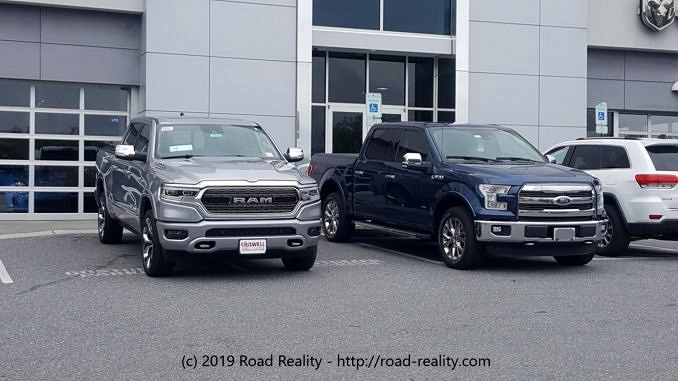

I get this line of questioning a lot – What made you buy a RAM? What’s it got that your Ford didn’t? What do you like better about it?
In order to answer these questions, we’ll be taking a deep dive into the design, features, and functionality of the 2019 RAM 1500 Limited I bought earlier this year, as well as the 2015 Ford F-150 I traded in. In the case of running changes to the F-150, I’ll mention those for a better apples-to-apples comparison.
The answers to these questions are multifaceted. There’s a lot to like about both trucks, and even my toddler still misses “the blue truck” (F-150) from time to time. Let’s break it down into several categories.
Exterior Design: Tie
The RAM 1500 has a sleek and curvaceous exterior, more akin to a luxury car than a truck. It’s got a very un-trucklike set of curves and a limited amount of chrome, unlike its contemporaries. It’s design is in stark contrast to the F-150, which has a squared-off look, plenty of shiny chrome-plated parts, an oversized grille, and few curves. They still look like trucks with their boxy cabs and beds, and both are handsome in their own right. Both are also offered in one of several colors, but the Blue Jean Metallic hue of my F-150 is still more pleasing to this writer’s eye. The Billet Silver found on the RAM does appear cleaner, even if it hasn’t been washed in weeks. The adage goes that beauty is in the eye of the beholder, so this makes Design the most subjective of categories, even if the question was posed to me and nobody else.
Interior Design: RAM 1500
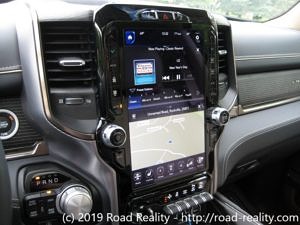 Hands down, it’s the RAM 1500. The F-150’s interior, which debuted in the 2015 model year, has not aged well. While GM continues to incrementally change their trucks’ interior design (and there are rumors that the oft-derided 2019 redesign is being subjected to an emergency redesign for 2021), RAM has leapfrogged both of them. And then there’s 800lb gorilla, the 12″ infotainment screen in the RAM. This really has FoMoCo and GM scrambling to slap a tablet on the dash of their workhorses. The F-150’s 8″ screen looks tiny in comparison, and its software, SYNC 2 (MyFord Touch 2) can’t hold a candle to the responsiveness and configurability of uConnect. Sure, you can change the background on MFT2, but with tablet-like capabilities baked into uConnect, there’s really no comparison. Beyond infotainment, the RAM’s instrument cluster productivity screen offers a level of customization above the Ford’s, even if it’s missing the pitch and yaw displays the F-150 boasts. I really liked those screens on my Ford when traversing hills, if for no other reason than curiosity. I’ve sampled the latest version of SYNC3 in newer Fords, and even with its faster-responding screen and more intuitive controls, the only place where SYNC wins is voice control.
Hands down, it’s the RAM 1500. The F-150’s interior, which debuted in the 2015 model year, has not aged well. While GM continues to incrementally change their trucks’ interior design (and there are rumors that the oft-derided 2019 redesign is being subjected to an emergency redesign for 2021), RAM has leapfrogged both of them. And then there’s 800lb gorilla, the 12″ infotainment screen in the RAM. This really has FoMoCo and GM scrambling to slap a tablet on the dash of their workhorses. The F-150’s 8″ screen looks tiny in comparison, and its software, SYNC 2 (MyFord Touch 2) can’t hold a candle to the responsiveness and configurability of uConnect. Sure, you can change the background on MFT2, but with tablet-like capabilities baked into uConnect, there’s really no comparison. Beyond infotainment, the RAM’s instrument cluster productivity screen offers a level of customization above the Ford’s, even if it’s missing the pitch and yaw displays the F-150 boasts. I really liked those screens on my Ford when traversing hills, if for no other reason than curiosity. I’ve sampled the latest version of SYNC3 in newer Fords, and even with its faster-responding screen and more intuitive controls, the only place where SYNC wins is voice control.
The seats are another sticking point. While Ford advertised 2015-2017 F-150s with “air conditioned” seats, they are slimmer than previous models, which means the cooling function didn’t work well without an aftermarket kit – still a sticking point on F-150 forums. In 2018, Ford removed the thermoelectric devices from the seats and advertised them as ventilated, which is still not impressing owners. Meanwhile, over at RAM, their ventilated seats work surprisingly well at forcing air-conditioned air into one’s back and bottom. I’ve been iced out on numerous occasions in the RAM, whereas the Ford’s seats never got too cold. The heated seat function on both trucks works well, but here again the RAM wins for seats that get uncomfortably hot, and quickly.
The sometimes controversial shift knob in the RAM frees up space for a configurable center console, another place the RAM wins on the inside. The 1500’s console is simply massive and quite user-friendly, offering wireless charging, which wasn’t even available on the F-150.
Tech: RAM
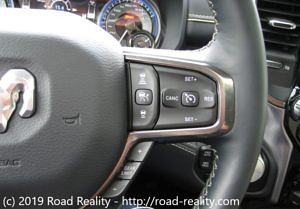 I already mentioned the difference in infotainment systems, but there’s other tech on these trucks worth mentioning. The driver assistance suite is vastly improved in the 2019 RAM 1500 over the 2015 Ford F-150, with an advanced Adaptive Cruise Control system and a blind spot monitoring system that takes your trailer into account. In 2017, the F-150 got its second-generation ACC and gained stop-and-go functionality, tying the RAM, but the F-150 has Pro Trailer Backup Assist, so it’s a tie there. Both feature 360-degree cameras, but the clarity of the RAM’s cameras is a notch higher, especially at night. Both also feature rear parking sensors, but the 1500 includes front ones too, a feature not available on any trim of F-150. To be fair, Ford was first to market a truck with many of today’s ubiquitous technology features, especially driver assistance, but the RAM’s systems are more advanced, so it gets the edge here.
I already mentioned the difference in infotainment systems, but there’s other tech on these trucks worth mentioning. The driver assistance suite is vastly improved in the 2019 RAM 1500 over the 2015 Ford F-150, with an advanced Adaptive Cruise Control system and a blind spot monitoring system that takes your trailer into account. In 2017, the F-150 got its second-generation ACC and gained stop-and-go functionality, tying the RAM, but the F-150 has Pro Trailer Backup Assist, so it’s a tie there. Both feature 360-degree cameras, but the clarity of the RAM’s cameras is a notch higher, especially at night. Both also feature rear parking sensors, but the 1500 includes front ones too, a feature not available on any trim of F-150. To be fair, Ford was first to market a truck with many of today’s ubiquitous technology features, especially driver assistance, but the RAM’s systems are more advanced, so it gets the edge here.
Power: F-150

Power levels are 365hp/420lbft for the EcoBoost and 395hp/410lbft for the HEMI, but that doesn’t tell the whole story. The F-150’s EcoBoost 3.5-liter twin-turbo V6 is a powerhouse, plain and simple. Its low-end torque is addictive and moves the truck smartly, while the RAM 1500’s HEMI 5.7-liter V8 with eTorque is new-school mixed with old-school. It’s a traditional V8 with a mild hybrid system integrated into it. EPA-estimated fuel economy is almost exactly the same from one to the other at 17/22/19 city/highway/combined for the RAM and 17/23/19 for the Ford. (Caveat: Ford adjusted the fuel economy ratings for the exact same truck in 2016 to 16/22/18, more in line with what I experienced.)
In real-world use, however, the big, tall torque curve of the EcoBoost makes for a much quicker truck than the HEMI and its electric motor, even if it isn’t as smooth. Power delivery is much more linear for the HEMI, as is to be expected when comparing a naturally-aspirated engine with a turbocharged one. The low-end torque means fewer downshifts during mild to medium acceleration. The RAM will downshift with a steady headwind or slight incline.
Drivetrain: RAM
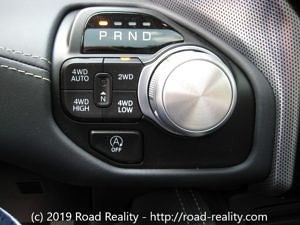 With the eTorque electric motor smoothing out shifts and adding off-the-line grunt, the RAM edges out the Ford in this category. The ZF-sourced 8-speed automatic in the 1500 is 2 gears better than the Ford’s 6-speed, and with shorter (numerically higher) gearing in the RAM, the HEMI’s grunt is put to good use. There’s no way to accurately compare these drivetrains since they’re so different, other than the aforementioned smoothness of the RAM’s transmission. Ford has since replaced its 6-speed with a 10-speed automatic co-engineered with GM. The 10-speed has seen way more complaints than the RAM’s 8-speed, versions of which are used by many automakers. Other than the occasional rough 4-3 downshift, the RAM is just plain better.
With the eTorque electric motor smoothing out shifts and adding off-the-line grunt, the RAM edges out the Ford in this category. The ZF-sourced 8-speed automatic in the 1500 is 2 gears better than the Ford’s 6-speed, and with shorter (numerically higher) gearing in the RAM, the HEMI’s grunt is put to good use. There’s no way to accurately compare these drivetrains since they’re so different, other than the aforementioned smoothness of the RAM’s transmission. Ford has since replaced its 6-speed with a 10-speed automatic co-engineered with GM. The 10-speed has seen way more complaints than the RAM’s 8-speed, versions of which are used by many automakers. Other than the occasional rough 4-3 downshift, the RAM is just plain better.
Elsewhere in the drivetrain, both feature 4WD, with high, low, and Auto modes. I haven’t had to drive the RAM in any snow or off-road yet, so my impression of it may change.
Ride and Handling: RAM
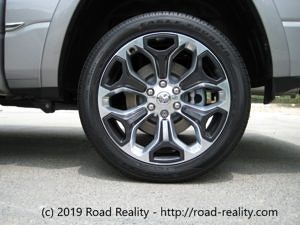 Life is full of compromise. If you want a sportier truck, get the Ford. If you want to be isolated from the roughness beneath your truck’s tires, get the RAM. The air suspension on the RAM soaks up bumps surprisingly well. Rough pavement is no match for the airbags. Its cross-town rival simply handles better. In almost all situations, the Ford is better composed and goes around corners with aplomb for a nearly 3-ton vehicle. It’s no sports car, but short of hitting closely spaced bumps, it’s unflappable. The RAM is just not as confidence inspiring, wanting to wallow around corners on its pillowy suspension. Even with low profile tires on the 22″ wheels, the RAM has too much body roll. I’ll gladly take that over the Ford’s willingness to skip out its rear end – there are spots on my morning commute which would send the F-150’s back tires skidding sideways, whereas the RAM telegraphs to the driver, “Hey, I got this. No worries!”
Life is full of compromise. If you want a sportier truck, get the Ford. If you want to be isolated from the roughness beneath your truck’s tires, get the RAM. The air suspension on the RAM soaks up bumps surprisingly well. Rough pavement is no match for the airbags. Its cross-town rival simply handles better. In almost all situations, the Ford is better composed and goes around corners with aplomb for a nearly 3-ton vehicle. It’s no sports car, but short of hitting closely spaced bumps, it’s unflappable. The RAM is just not as confidence inspiring, wanting to wallow around corners on its pillowy suspension. Even with low profile tires on the 22″ wheels, the RAM has too much body roll. I’ll gladly take that over the Ford’s willingness to skip out its rear end – there are spots on my morning commute which would send the F-150’s back tires skidding sideways, whereas the RAM telegraphs to the driver, “Hey, I got this. No worries!”
Truck Stuff: RAM
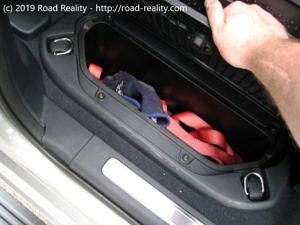 This category also has some controversial answers to it, since my F-150 was a Lariat trim level (comparable to RAM’s Laramie trim, 2 levels below a RAM Limited). There were a couple of options I didn’t get on the Ford that come standard on the 1500’s Limited trim level, the most notable of which are the power running boards. Same basic design between both trucks, but the RAM’s feel sturdier than ones I experienced on F-150s.
This category also has some controversial answers to it, since my F-150 was a Lariat trim level (comparable to RAM’s Laramie trim, 2 levels below a RAM Limited). There were a couple of options I didn’t get on the Ford that come standard on the 1500’s Limited trim level, the most notable of which are the power running boards. Same basic design between both trucks, but the RAM’s feel sturdier than ones I experienced on F-150s.
Bed access is a sticking point. My wife and I loved the tailgate step on the Ford, but no such thing is available on RAM’s trucks. There is, however, a deployable bed step. Combined with the rear stake pocket on the RAM’s bed rail, it makes lemonade out of lemons. I’ve found that the stake body pocket at the end of the driver’s side bed rail makes for a surprisingly good handhold to step up onto the tailgate, and the bed step can be used with or without the tailgate being lowered, so it garners extra points in this regard.
Storage is definitely one of the RAM 1500’s strong suits. With under floor storage built in and cubbies galore, the RAM can hide your bungee cords, blankets, tie-down straps, and tools, all without requiring aftermarket solutions. And this is without the optional RAM Boxes, which convert the bed rails and the area above the wheel wells into lockable storage containers – the only big-ticket item I didn’t get on my truck.
Then we come back to the RAM’s air suspension. With Entry/Exit mode, the tailgate is closer to the ground than the Ford’s, making loading and unloading easier, and trailer connections are made easier by lowering the truck, backing up the hitch ball underneath the trailer’s coupler, and lifting the truck again, locking the trailer in place. The air suspension also self-levels loads, a helpful feature when most trucks with serious weight in their beds would have headlights looking skyward.
Off the beaten path, the RAM’s Off Road 1 and Off Road 2 ride heights mean better approach, breakover, and departure angles than the Ford. The F-150’s FX4 off-road package includes decent all-terrain tires, whereas the Limited came equipped with highway-biased tires, so anything more than a gravel road should include a trip to the tire store for better rubber on the 1500. I’m currently considering ordering winter wheels and tires for the RAM to improve its performance in inclement weather.
The Ford’s payload and towing capacity are better, by 275lbs and 250lbs, respectively. But where the Ford requires the Max Tow package to reach its 11,500lb towing capacity, the RAM requires nothing more than the optional trailer brake controller to be able to drag 11,250lb. The payload capacity is a bigger real-world difference for an owner like me, with 1,575lbs on the F-150 compared to 1,320lbs on the RAM. Most of that is due to the RAM’s heavier steel sheetmetal and more luxurious options. For most of my hauling duties, I won’t notice much difference, but my daily driving sure appreciate the amenities offered on the RAM. Again, compromise.
Owner Experience: TBD
This one has no winner, since I put 36,000 miles on my F-150 before trading it in, and only 8,500 miles on my new RAM so far. Still, I prefer driving the RAM over the F-150, because it’s just so smooth and luxurious, yet it hauls almost as much payload and tows my 7,000lb enclosed trailer with ease. There’s no drivetrain vibrations to deal with on the RAM, and its transmission has no weird grinding noises like on my F-150, which started in on my nerves at around 350 miles. There’s also the continuing issues that plague F-150 owners, namely the aforementioned inadequate cooling in the seats, as well as frozen door locks during the colder months.
Overall Winner: RAM
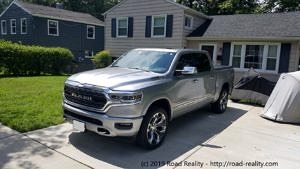 OK, foregone conclusion much? Of course the RAM would win, but now we have examined why. And I’m not the only one. RAM is getting a significant number of conquest buyers – guys and gals who used to have a competitor’s truck. From handsome looks to competitive capability, wrapped up with a tech-laden luxurious interior featuring impressive creature comforts and the smoothest ride in truckdom, the RAM presents a compelling case for itself. While it isn’t perfect, the RAM threads a fine needle between being a luxury car and a half-ton pickup truck, and right there at that intersection you’ll find plenty of buyers like myself. Even with decades of Ford ownership under my belt, the continuing issues and lackluster build quality with the Blue Oval trucks I’ve owned have led me to buy a RAM. Stick with Road Reality for continuing analysis and my experience with the first FCA product I’ve ever bought.
OK, foregone conclusion much? Of course the RAM would win, but now we have examined why. And I’m not the only one. RAM is getting a significant number of conquest buyers – guys and gals who used to have a competitor’s truck. From handsome looks to competitive capability, wrapped up with a tech-laden luxurious interior featuring impressive creature comforts and the smoothest ride in truckdom, the RAM presents a compelling case for itself. While it isn’t perfect, the RAM threads a fine needle between being a luxury car and a half-ton pickup truck, and right there at that intersection you’ll find plenty of buyers like myself. Even with decades of Ford ownership under my belt, the continuing issues and lackluster build quality with the Blue Oval trucks I’ve owned have led me to buy a RAM. Stick with Road Reality for continuing analysis and my experience with the first FCA product I’ve ever bought.
by John Suit
